Results 11 to 20 of 25
Thread: 1700s Gronstrand pair in ivory
-
10-29-2013, 02:20 AM #11

Mostly experience. These would have had a glaze or crocus finish, and the grinding is very obviously a rough grinding that you often see from oldschool regrinds - hard to tell from pictures, but once it's in person you can tell (I was hoping these were original finish from the seller's pics, but probably not the case). Also, there is evidence of pitting that has been sanded down in the past, so I know that someone has tried refinishing at least parts of the blade.
edit: also, just because something is reground, doesn't mean the shape has to be drastically altered. What I've seen from razors of this period, is that often they would grind not only the blade, but also the tang and tail. This was often done very well, and it's sometimes hard to detect unless you know what you're looking at. But the grinding would take such a small amount of steel off that you can't judge based on the shape of the blade whether it has been ground.
-
10-29-2013, 02:23 AM #12Senior Member


- Join Date
- Jan 2011
- Location
- Roseville,Kali
- Posts
- 10,432
Thanked: 2027
They are not reground blades JMO
-
10-29-2013, 03:34 AM #13

Never heard of them but the name "Grönstrand" is quite normal here, (Grön - Green, Strand - Beach)
Think I just found him; Grönstrand, Nils, rakknivssmed. (Rakkniv - Straight Razor, Smed - Smith)
He is mentioned in a book; Eskilstuna, en Svensk märkesstad: kloster-, slotts- och industri-stadens öden genom seklerna i historisk belysning, by Knut Hellberg, written in 1919 - 1920 about industries in Eskilstuna.
Digitalen: Eskilstuna en märkesstad del 1 och 2 1919
Here comes the crux, part 1 and 2 of the book is digitalized, not part 3 that he's in!Hur Svenska stålet biter kom låt oss pröfva på.
-
10-29-2013, 03:41 AM #14Senior Member




- Join Date
- Nov 2012
- Location
- Across the street from Mickey Mouse in Calif.
- Posts
- 5,320
Thanked: 1184
I am thinking like pixel on this one. Not that I know much but they would have had to grind a lot of detail and the stamp would be missing. The hollow would be a rather course grind in the first place.
Good judgment comes from experience, and experience....well that comes from poor judgment.
-
10-29-2013, 03:56 AM #15

These razors were almost certainly put on a grinding wheel to clean off rust and remove pitting. It was a thing that was done pretty commonly.
I know these days when we see 'regrind' we think of an old wedge that's been concaved, but that isn't always what it meant.
Henry Lummus complained about the practice:
By analogy to other antiques, an old razor of good style, in proof condition, with the original polish unimpaired by grinding, excessive honing, or rust, and with a perfect original handle, is a prize. But such a condition rarely obtains, and usually the grinder must be employed to restore the blade by removing rust and grinding out the long bevel caused by many years of honing.Last edited by Voidmonster; 10-29-2013 at 03:58 AM. Reason: fixed a transcription error
-Zak Jarvis. Writer. Artist. Bon vivant.
-
10-29-2013, 04:03 AM #16

Well that explains why my searching through the digitized versions turned up nothing, ha.
Looking at it again, I'm 99.99% certain this has been reground. Stamps go deep, and usually are left intact after regrinding (we're talking a light brush on the surface to get it shiny again, which doesn't take off a lot of metal. Nowadays when we hear 'regrind' we often associate it with changing some shape of the blade). See below:I am thinking like pixel on this one. Not that I know much but they would have had to grind a lot of detail and the stamp would be missing. The hollow would be a rather course grind in the first place.
Wostenholm, complete regrind of blade face, tang, and tail. This one has little spots of crocus polish left, so I know with absolute certainty it was reground; but on first inspection you might not be able to tell. Also, the angles on the tang have been kept very sharp:
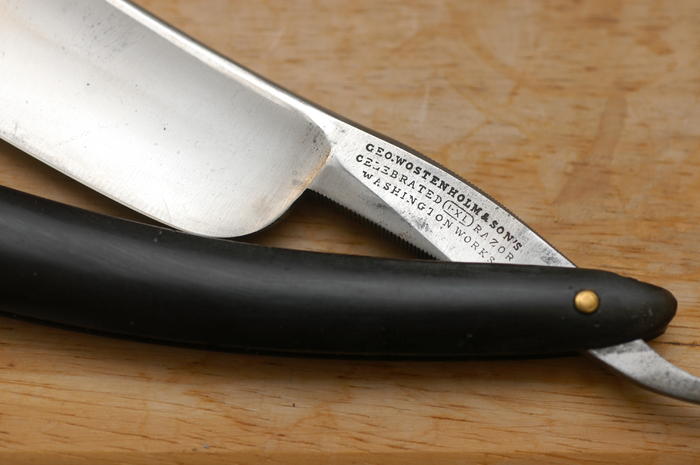
Aux, complete regrind all over. Clark and Hall, ground on the blade:
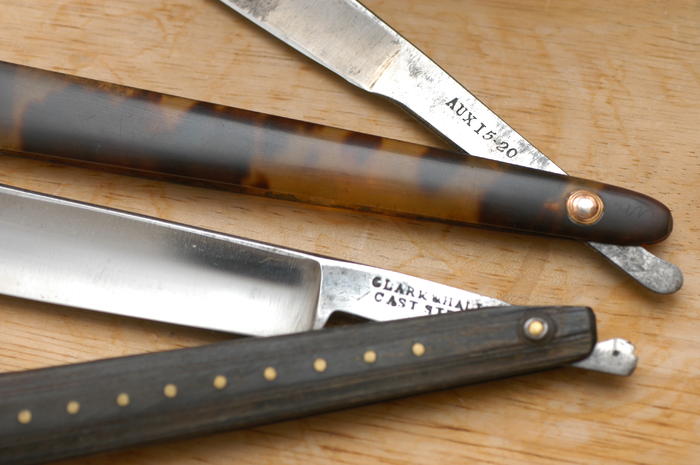
Again, it's hard to see from the photographs, but the surface is quite roughly finished by razor standards even though it looks like a mirror. The maker would have finished them to a higher degree before releasing them.
-
10-29-2013, 04:32 AM #17

This might help clarify:
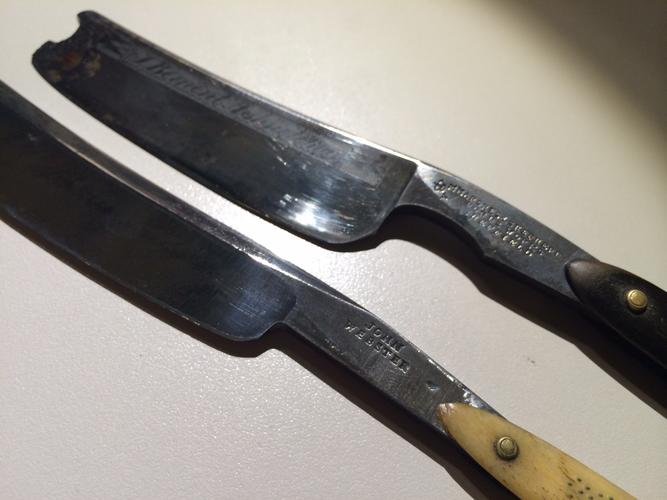
Two razors, one has had its finish reground, the other hasn't.
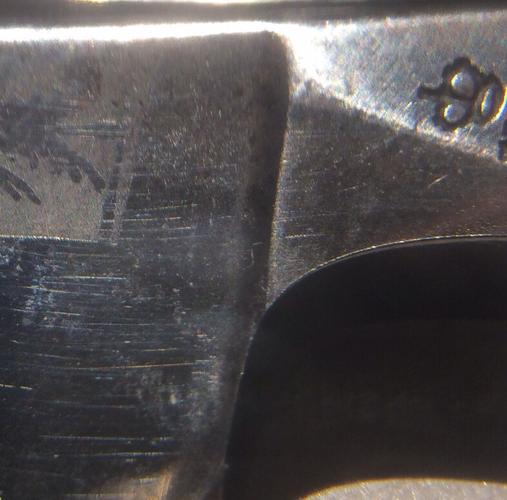
In the closeup, it's obvious.
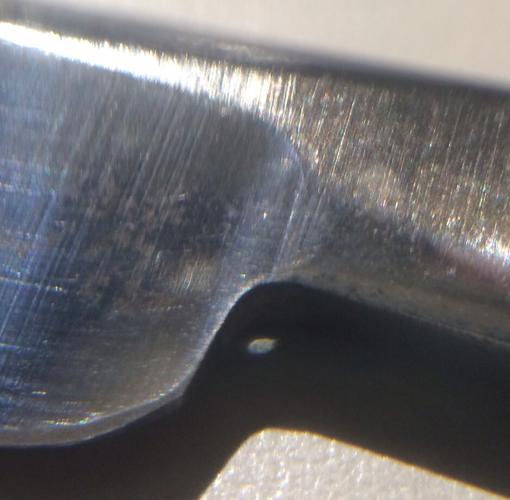
Yet another reason you've got to be careful buying things from eBay. It can be really hard to spot in a photo, depending on the light.-Zak Jarvis. Writer. Artist. Bon vivant.
-
11-03-2013, 03:45 PM #18

Here's the pair after some cleaning. I unpinned them and sanded to get the active rust off. I approximated a glaze finish on the tangs and crocus on the blades. Upon taking them apart, there was about a 0.5-1 mm dip in the steel before the point that was covered by the scales, so they'd had some drastic reshaping done, but I'm not sure if they'd ever been unpinned. There's also a slight angle change on the bottom of the tang, which usually happens when a shoulder is cut in, but in this case I think these blades were much bigger originally.
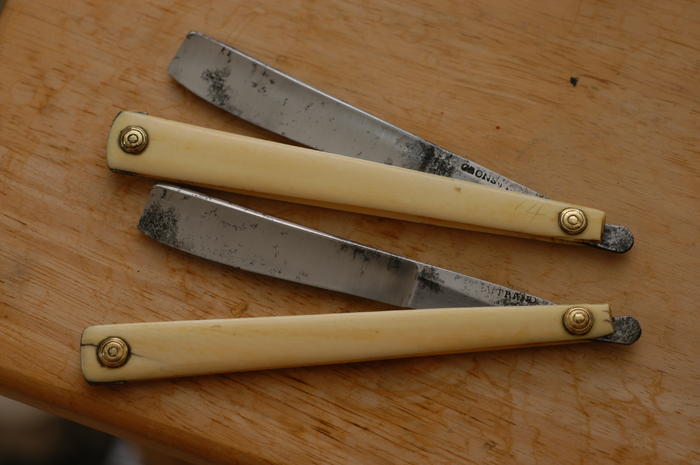

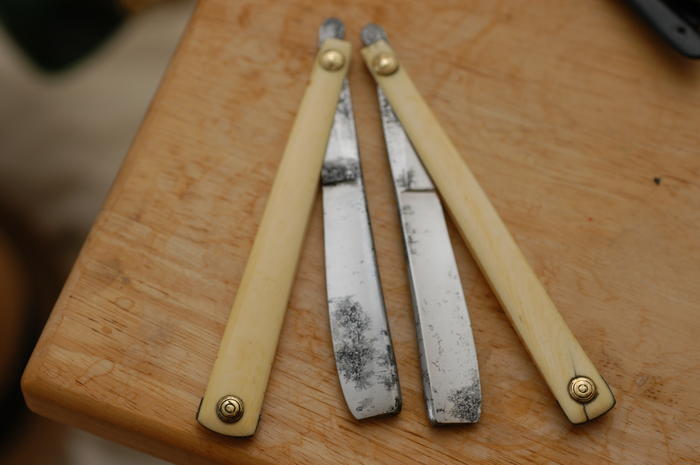
-
11-03-2013, 05:10 PM #19Junior Member

- Join Date
- Mar 2012
- Posts
- 22
Thanked: 0
I don't have the experience go the other posters here, thanks for showing these off. It really helps with my education on these. It seems that a good way to look for the regrind would be to look for striations in the blade. I am curious why wouldn't the person doing the regrind wouldn't try and polish those out? From these pics I don't see striations on the blades.
-
11-03-2013, 06:47 PM #20

Regrinding, especially back in the early 1800's, consisted of 1) a guy who knew (or mostly knew) how to do it 2) a stool 3) a grinding wheel, powered by a pedal. Some grinders had more things -- the tools to take apart and reassemble, the scales to completely rescale, etc -- but the most common one was a guy sitting on a street corner somewhere, or just between two buildings, shouting that he'd grind your razors for {small amount of money}.
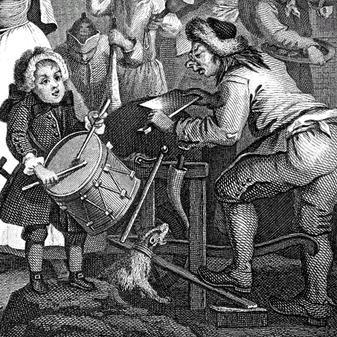
Detail from Hogarth's "The Enraged Musician", 1741. A knife grinder.
Some street grinders specialized, but many would use their wheel on anything you paid them to do.
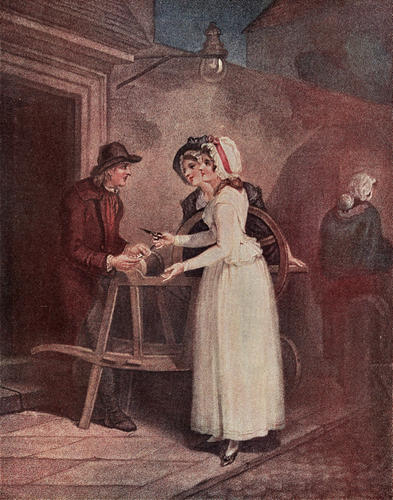
Cries of London, Plate 6 'Knives, Scissars, and Razors to Grind.' by F. Wheatly R.A., engraved by Giovanni Vendramini, 1795
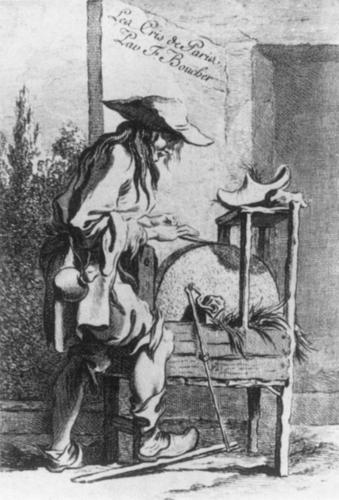
'The Cries of Paris - The Knife Grinder' by Simon François Ravenet, 1737
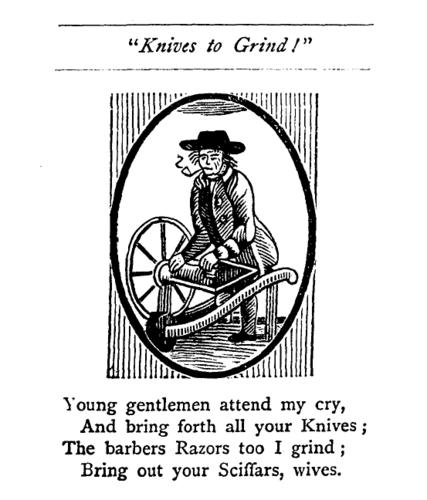
Engraving from "Old London Street Cries and the Cries of To-day" by Andrew White Tuer and Thomas Rowlandson
It was a practice that continued on for a long, long time.
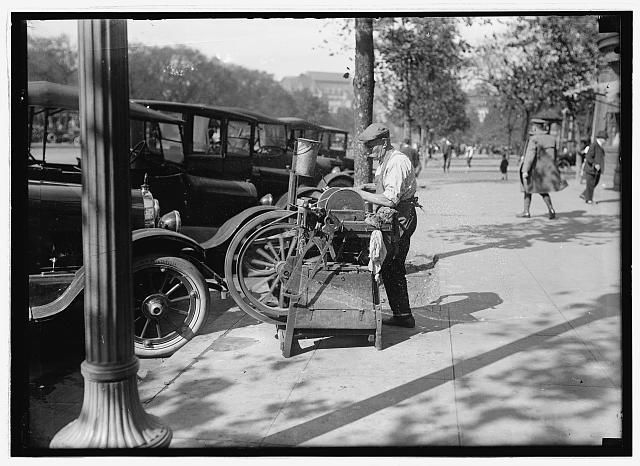
Knife grinder, Washington D.C. -- by Herbert A. French, sometime between 1912 and 1930
You might notice a common element here. There are zero grit progressions or alternates. The street grinder had one stone and he used that for all its worth.-Zak Jarvis. Writer. Artist. Bon vivant.
-
The Following 6 Users Say Thank You to Voidmonster For This Useful Post:
bartds (09-28-2020), BobCochran (07-04-2014), PaulFLUS (09-28-2020), Phrank (11-03-2013), Thaeris (11-07-2013), Toroblanco (09-29-2020)


 71Likes
71Likes LinkBack URL
LinkBack URL About LinkBacks
About LinkBacks








 Reply With Quote
Reply With Quote